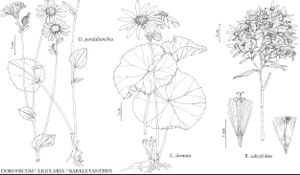Doronicum
Sp. Pl. 2: 885. 1753.
Gen. Pl. ed. 5, 377. 1754.
| Taxon | Illustrator ⠉ | |
|---|---|---|
 | Doronicum pardalianches Ligularia dentata Barkleyanthus salicifolius | Yevonn Wilson-Ramsey Yevonn Wilson-Ramsey Yevonn Wilson-Ramsey |
Perennials, 10–60 (–90) [–150+] cm (rhizomes sericeous at nodes [glabrous or glabrate]). Stems usually 1, erect. Leaves basal and cauline; alternate; petiolate (petiole bases sometimes dilated, clasping) or sessile; blades palmati-pinnately or pinnately nerved, elliptic, lanceolate, ovate-orbiculate, or ovate [oblong, pandurate, spatulate], margins entire or crenate to denticulate, faces glabrous or arachnose to pilose, sometimes glandular-pubescent (especially along veins). Heads radiate, borne singly or in corymbiform arrays (peduncles often glandular-pubescent). Calyculi 0. Involucres campanulate to hemispheric or broader, 22–40 mm. Phyllaries persistent, 21–30+ in 2–3+ series, erect to spreading, distinct or nearly so, lanceolate to lance-linear or subulate, equal to subequal, margins seldom scarious (often ciliate). Receptacles convex to hemispheric, smooth or foveolate (pilose), epaleate. Ray-florets [13–] 21–40+ (more in horticultural doubles), pistillate, fertile; corollas yellow. Disc-florets [50–] 100–250+, bisexual, fertile; corollas yellow, tubes shorter than to equaling funnelform throats, lobes 5, erect or recurved, lance-deltate to lance-linear (lengths to 5 times widths); style-branches: stigmatic areas continuous, apices rounded to truncate. Cypselae flattened, broadly obovate, 5-ribbed or 10-ribbed, glabrous or hairy; pappi persistent, usually of 40–60, white or stramineous, barbellulate bristles (in 1–2 series), sometimes 0 in ray-florets (e.g., D. pardalianches). x = 30.
Distribution
Introduced; Eurasia
Discussion
Species 35 (3 in the flora).
The three doronicums in the flora are seldom encountered outside cultivation.
Selected References
None.
Key
| 1 | Blades of basal leaves ovate to elliptic or lanceolate, bases cuneate | Doronicum plantagineum |
| 1 | Blades of basal leaves ovate-orbiculate, bases cordate | > 2 |
| 2 | Cauline leaves 1–2(–3); heads borne singly | Doronicum orientale |
| 2 | Cauline leaves 3–7(–10); heads 3–12(–17) | Doronicum pardalianches |
"broader" is not a number.